11

STEP-MES-based investigations view episodic phenomena as involving both sequential and concurrent interactions.. During episodes involving interventions during the episode, concurrent interactions occur wheh people or things intervene to try to change what is happening to improve the outcomes. Were the intervention actions appropriate, or could they be changed to produce different outcomes?
I developed the Time/Loss Analysis method while at NTSB to evaluate intervention actions and their effects with actual or estimated measures of performance over time. I was motivated to do this by the losses among intervenors at accidents I investigated. T/LA displays provided me a measure of intervention effectiveness, and insights into the underlying strategies and tactics intervenors employed and their effects on the intervention results.
T/LA involves several steps:
- select an episode to assess
- interview or read reports of the responders who intervened
- interview or read reports of individuals who can estimate non-intervention and intervention effects
- chart the data available in T/LA format
- review results for actions as potential BBs
The objective of this Guide is to provide procedures for measuring, displaying and assessing the outcomes produced by intervention actions of personnel, equipment, and procedures during episodic occurrences. It also provides insights into the effects of loss control strategies on intervention effectiveness.
T/LA is applicable to any known scenario involving intervention actions intended to reduce the loss, harm or injury during an unintentional, natural or intentional episode.
This section describes the data needed to prepare a T/LA display. The method emphasizes the SHAPES of cumulative loss curves, rather than the quantitative location of points on the curves. Thus T/LA tolerates estimated data well, and can even function adequately with estimated ranges of losses and times if the estimator(s) are reasonably consistent with their inputs.
The intervention actions must be described in the MES Event Building Block format to permit additional analysis with MES Worksheets if required.
Data required to prepare a T/LA curve include:
1. The time when the episode began.
2. The estimated time when each loss began and when it reached its ultimate severity in the episode.
3. Estimates of loss levels at various times during the episode.
4. An estimate of the loss levels over time if no person or thing had intervened, and the episode had run its course without outside intervention.
5. Data about specific intervention actions taken during the response, and the approximate times those actions were initiated.
6. The expected effects of each intervention action taken, at the time they were taken.
Data sources vary with each incident, and must be identified by the investigator, using techniques described in Guide 1 and other sources. Some general data sources are listed below.
1. Witnesses and debris can indicate when specific loss events occurred, within workable tolerances. They can usually provide reasonably accurate information about the times when an episode began to affect them, and when the effects reached certain stages of harm.
2. Property damage data are usually less precise, but a consensus can be reached by involving well-informed individuals like the property owner, designers, maintenance personnel, fire marshal or insurance appraisers. "Best estimates" and consensus opinions are acceptable for most purposes. A helpful technique is to develop a total loss value, and then work with increments of that total to develop losses over time.
3. After an incident scenario is understood, get estimates of the loss line if no intervention had been attempted (natural loss line). One approach is to track the potential energy exchanges between sources and exposed targets, and project the likely harm that would reasonably have been expected to occur. Here too use of consensus-building methods such as abbreviated Delphi techniques can be helpful if the expertise is available and willing to help.
4. If disagreement exists, high/low loss estimates at successive times are acceptable and can be displayed on the T/LA charts as hi curve/ low curve formats..
Data are arranged for analysis in a plot showing changes in cumulative loss vs. elapsed time during an episode. Please study the example shown in Figure 4-1.
Figure 7-1 Example of T/LA Plot
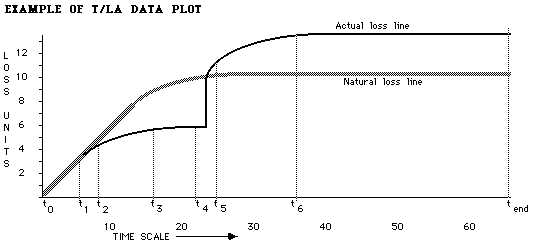
The first step in the procedure is to acquire the episode data described above. After acquiring the data following an episode, plot the data on a T/LA time/loss matrix in the form show in Figure 4-1.
1. Prepare a set of plotting coordinates. The horizontal axis along the bottom margin is labeled "time." The scale begins at the moment the episode begins,and ends at the time of the last loss. Divide the scale into equal increments, and do not change it. The vertical axis is labeled the "loss." Show scales for fatalities, injuries and property damage separately along the left margin. Scales are numbered from 0 to the value of the maximum loss or the total elapsed time of the incident.
2. Plot the points for a line to represent each type of loss, showing the estimated cumulative loss value at selected times, accumulated as time elapsed during the mishap.
3. Plot the points for an estimated natural loss line(s) if no intervention had been attempted during the episode.
4. Plot the time each person arrived at the emergency after all the loss lines are in place, and then draw a vertical line upward from that time coordinate to the loss lines plotted in 2 and 3 above.
5. Label all the data points and add Chart Title Block describing the episode being plotted.
T/LA plots indicate several general categories of uses.
1. Interpret segments. As a rule, the steeper the loss line slope, the less acceptable the intervention performance. Interpret the loss line in two segments.
a) The first segment is the actual loss line from time zero at the intersection of the axes until the intersection with the earliest intervention (vertical line drawn up from the time coordinate.) This reflects the period during which losses must be controlled by the equipment and safeguards built into the system. For example, injuries occurring in an automobile collision before response personnel arrive reflect performance of safeguards, built into the highway, vehicle and traffic system.
b) The performance of the built-in equipment, safeguards and procedures must be judged successful or unsuccessful based on the slope of the loss line in Segment 1. If cumulative losses increase rapidly, before intervenors can arrive, the performance of the built-in loss control safeguards must be vigorously analyzed.
c) The importance of designing hardware to provide time for victims to respond to dangerous situations without loss becomes evident from these loss line slopes. The steeper the slope between time zero and time zero + about 5 minutes, the less effectively the loss control system performed.
d) The second segment is the loss line from the first intervenor's arrival until the last harm occurs. That Segment is dependent on the ability of the intervenors to influence what happens after their arrival. For example, after the first intervenor arrives on scene, the loss line should flatten out quickly if the intervenors are successful.
e) A steeply sloping loss line after the arrival of intervenors suggests that either 1) the system was uncontrollable or 2) the response action actually succeeded in reversing the loss trend.
2. Actual vs. natural loss line. Compare the actual loss line with the loss line that would have occurred without intervention (natural loss line). If the natural loss line differs materially from the actual loss line, two conclusions are possible.
a) If the actual loss line is ABOVE the natural loss line, it suggests that intervention INCREASED the losses in the incident, and the intervention must be judged unsuccessful. These circumstances demand cautious but penetrating scrutiny.
b) If the actual loss line is BELOW the natural loss line, the response actions must be judged successful. The difference in the areas under the curves represents the degree of improvement achieved by the response actions. The greater the area between the natural and actual loss lines, the greater the VALUE of the intervention.
c) The duration of the loss line may indicate degree of success of the intervention, although delays in bringing the episode to an end should be included in the loss estimates.
3. Increasing slope. Sometimes the natural or actual loss lines increases during an episode. Such increases indicate a dynamic or secondary loss potential that could trap response personnel When harm escalates, at least 3 deficiencies must be considered: deficient design, deficient machines or deficient people.
4. Special cases. Intervention may produce a reduced loss over time, or loss continues to grow because means to intervene are not known. See examples 5 and 6 in Figure 4-2 on the following pages.
Figure 7-2 Examples of Typical T/LA Curves
|
1. DESIRABLE
This represents a typical response curve when human intervention is required. The loss builds for a time before the intervenors can reach the episodic occurrence, but its growth is ended shortly after they intervene. The ideal curve would have a small loss growth before intervention is accomplished.
|
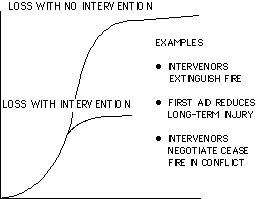
|
|
2. OBJECTIONABLE
When the intervention increases the losses, the intervention must be judged undesirable, unsatisfactory, or unacceptable.
This kind of outcome merits close scrutiny of reasons the curve developed.
|

|
|
3. CASCADING
Loss among intervenors during the unexpected escalation of the episode during intervention adds to the loss that would otherwise have occurred
|
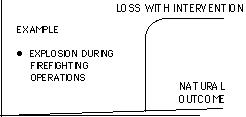
|
|
4. OVERWHELMING
The loss buildup occurs so rapidly that the episode is essentially over before effective intervention can be introduced. In such cases, intervention must be in place before an episode begins, or is introduced after the loss occurs to ameliorate the harm.
|
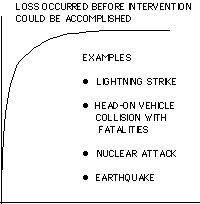
|
|
5. CRESTING
Loss peaks then declines naturally with no specific intervention action. Needs to be recognized as candidate for no-action option choice.
|
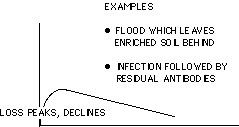
|
|
6. UNTREATABLE
Some loss scenarios pose special challenges to intervenors because they are not understood or else effective options for intervention remain unknown.
|
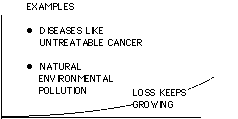
|
FIND BBs IN CURVES
Intervention involves actions by intervenors. To find data for STEP-MES input BBs with T/LA, investigate the actions of the state changers which motivated intervention actions by the intervenors. Usually what was happeing to motivate intervention can be found in after-action reports of intervenors. Sometimes other sources like eye witnesses or reporters or photographers, or citizens with smart phones taking photos during incidents and posting them on social media can provide data about what was happening before and after intervention to support documenting the curves, opening the door for finding data for BB documentation.
Creating tentative STEP-MES matrix arrays with incoming data about the episode intervention will help produce BBs of value.
Changes in the curves offer starting points for this process.
Note that the curves can also help analysts looking for appropriate responses to the episode from among alternative intervention points that would change the curves.

Go to Guide:
0
1
2
3
4
5
6
7
8
9
10
11
![]()
![]()